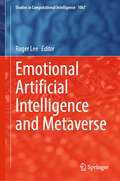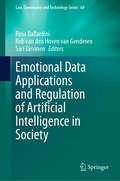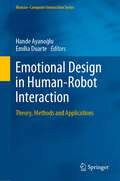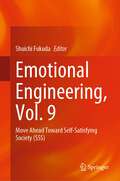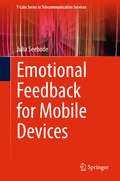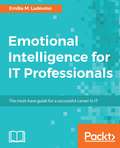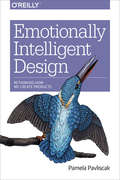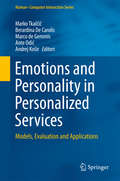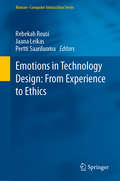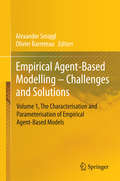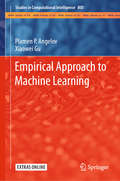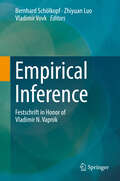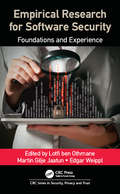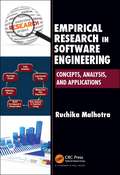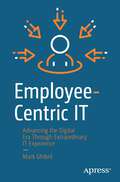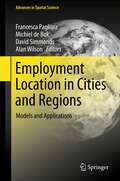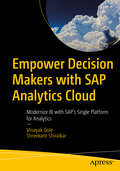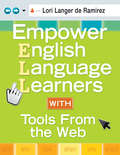- Table View
- List View
Emotional Artificial Intelligence and Metaverse (Studies in Computational Intelligence #1067)
by Roger LeeThis edited book presents scientific results of the 1st ACIS International Symposium on Emotional Artificial Intelligence & Metaverse (EAIM) which was held on August 4-6, 2022, in Danang, Vietnam. The aim of this symposium was to bring together researchers and scientists, businessmen and entrepreneurs, teachers, engineers, computer users, and students to discuss the numerous fields of computer science and to share their experiences and exchange new ideas and information in a meaningful way. All aspects (theory, applications, and tools) of emotional artificial intelligence and metaverse, the practical challenges encountered along the way, and the solutions adopted to solve them are all explored here in the results of the articles featured in this book. The symposium organizers selected the best papers from those papers accepted for presentation at the symposium. The papers were chosen based on review scores submitted by members of the program committee and underwent further rigorous rounds of review. From this second round of review, 15 of the symposium’s most promising papers are then published in this Springer (SCI) book and not the symposium proceedings. We impatiently await the important contributions that we know these authors will bring to the field of emotional artificial intelligence and metaverse.
Emotional Data Applications and Regulation of Artificial Intelligence in Society (Law, Governance and Technology Series #69)
by Rosa Ballardini Rob van den Hoven van Genderen Sari JärvinenThis revolutionary new book on using AI to process human emotion data seeks to raise awareness for the topic, thoroughly discuss it from a multidisciplinary perspective and, by doing so, disseminate research findings that elaborate on the current and future regulatory needs for the responsible and ethical development and application of emotional AI. Biometric and psychological data of humans are the most sensitive data on human behavior. The book’s objective is to provide a holistic understanding of key challenges and propose novel, workable, substantive and methodological solutions for navigating current and future legal and ethical needs and dilemmas regarding the processes of developing and using emotional AI. Although both the academic community and political decision-makers continue to intensively discuss issues in the ethical regulation of AI, there is still a very limited understanding of both the opportunities and the risks in connection with emotional AI specifically. Yet, emotional AI is one of the most promising areas of AI developments and applications. Several of these innovations could be a welcome change in our society, as they could improve our well-being in various ways. That being said, these inventions require considerable investments. Thus, legal incentives such as IPRs are crucial to supporting investment in these fields. Further, these innovations might have negative effects on the privacy and autonomy of natural persons, raising both legal and ethical concerns. Thus, their legal and ethical acceptability, as well as their societal acceptance, might be challenged by several legal provisions in the EU, such as the GDPR; regulations on communications, social platforms, and marketing; and the draft AI Act. Yet, the current legal landscape for emotional AI in Europe is anything but clear – an aspect that becomes even more apparent when we consider the global picture of the regulatory framework for emotional AI. In this book, a diverse team of internationally respected experts addresses these issues, engaging in a multidisciplinary study into techno-economic-legal developments concerning emotional AI, its impacts, and the need for action. The book offers in-depth scientific and societally relevant insights on the past, present and future of AI in general, especially its many implications for law and policy. Although the primary target audience for the book are academics from the field of law, the book also offers sound guidance for legislators and general policymakers, as well as companies and organizations.
Emotional Design in Human-Robot Interaction: Theory, Methods and Applications (Human–Computer Interaction Series)
by Hande Ayanoğlu Emília DuarteWhile social robots participation increases in everyday human life, their presence in diverse contexts and situations is expected. At the same point, users tend to become more demanding regarding their roles, abilities, behaviour and appearance. Thus, designers and developers are confronted with the need to design more sophisticated robots that can produce such a positive reaction from users so as to become well accepted in various cases of use. Like this, Human-Robot Interaction has become a developing area. Emotions are an important part in human life, since they mediate the interaction with other humans, entities and/or products. In recent years, there has been an increase in the importance of emotions applied to the design field, giving rise to the so-called Emotional Design area. In the case of Human-Robot Interaction, the emotional design can help to elicit (e.g., pleasurable) or prevent (e.g., unpleasant) emotional/affective reactions/responses. This book gives a practical introduction to emotional design in human-robot interaction and supports designers with knowledge and research tools to help them take design decisions based on a User-Centred Design approach. It should also be useful to people interested in design processes, even if not directly related to the design of social robots but, instead, to other technology-based artefacts. The text is meant as a reference source with practical guidelines and advice for design issues.
Emotional Engineering, Vol. 9: Move Ahead Toward Self-Satisfying Society (SSS)
by Shuichi FukudaThis is the latest volume in the series of Springer titles on emotional engineering tracking the development of this field.Engineering has been based on the Euclidean space approach and it was numerical data-centric. In short, our engineering up to now has been control-based, i.e., on tactics and problem solving. When we realize AI consumes 10,000 times more energy than human brain, we understand how it is better to use 10,000 people’s minds. But current society is industrial society. The industrial revolution introduced division of labour and we started to work for others. But the tremendous consumption of energy indicates that we need to move toward another society. If we can make the next society a self-Satisfying society (SSS) and create a new sustainable society with greater mental wellbeing then many emerging problems will be solved and we can enjoy our lives better. Emotional engineering engages with this challenge.
Emotional Engineering, Vol.10: Emotional Engineering as a Culture for 22nd Century Civilisation
by Shuichi FukudaThis book is the latest volume in the series of Springer titles on emotional engineering, tracking the development of this field. In our society, "Culture" emerges at the dawn of each era, laying the foundation for the development of "Civilization," which is then passed on to the succeeding era. "Culture" embodies the timeless essence of human characteristics, transcending temporal and spatial boundaries, encompassing the visionary pursuit of the future and the relentless quest for self-realization. Both "Motivation" and "Emotion" stem from the Latin word Movere, denoting movement. Why do we, as living beings, bear the epithet "Creatures"? It is because we instigate movement to thrive. Unlike other animals, who move merely to subsist in the present, humans navigate life with an eye toward tomorrow. "Emotion” etymologically signifies "to move out" in Latin, implying the act of manifesting one's inner realm in the external world. However, as denoted by the term "VUCA" (Volatility, Uncertainty, Complexity, and Ambiguity, our society is rapidly evolving into a realm of increasing complexity and diversity, transitioning from the tangible to the intangible. While the tangible realm necessitates interaction, the evolving landscape calls for the intervention of technology. Technology delves into the realm of "How." Yet, "Culture" resides in the emotional domain, pondering "What" and "Why,", as does Engineering. The "Process" of daring to transform dreams into reality assumes paramount significance. History admonishes us that now is the opportune moment to forge a novel "Civilization" for the twenty-second century. Let us harness the power of Emotional Engineering to sculpt the twenty-second century "Civilization" into its best iteration. This book of collected chapters sums up this challenge and how we can meet it.
Emotional Feedback for Mobile Devices
by Julia SeebodeThis book investigates the functional adequacy as well as the affective impression made by feedback messages on mobile devices. It presents an easily adoptable experimental setup to examine context effects on various feedback messages and applies it to auditory, tactile and auditory-tactile feedback messages. This approach provides insights into the relationship between the affective impression and functional applicability of these messages as well as an understanding of the influence of unimodal components on the perception of multimodal feedback messages. The developed paradigm can also be extended to investigate other aspects of context and used to investigate feedback messages in modalities other than those presented. The book uses questionnaires implemented on a Smartphone, which can easily be adopted for field studies to broaden the scope even wider. Finally, the book offers guidelines for the design of system feedback.
Emotional Intelligence for IT Professionals
by Emilia M. LudovinoLearn the techniques used by the most successful IT people in the world. About This Book • Get real-life case studies for different IT roles, developers, testers, analysts, project managers, DBAs • Identify with your IT scenarios and take the right decision to move up in your career • Improve your EQ and face any difficult scenario confidently and effectively Who This Book Is For This book is for professionals across the IT domain who work as developers, administrators, architects, administrators system analysts, and so on, who want to create a better working environment around them by improving their own emotional intelligence. This book assumes that you are a beginner to emotional intelligence and will help you understand the basic concepts before helping you with real life scenarios. What You Will Learn • Improve your observation skills to understand people better • Know how to identify what motivates you and those around you • Develop strategies for working more effectively with others • Increase your capacity to influence people and improve your communication skills • Understand how to successfully complete tasks through other people • Discover how to control the emotional content of your decision-making In Detail This book will help you discover your emotional quotient (EQ) through practices and techniques that are used by the most successful IT people in the world. It will make you familiar with the core skills of Emotional Intelligence, such as understanding the role that emotions play in life, especially in the workplace. You will learn to identify the factors that make your behavior consistent, not just to other employees, but to yourself. This includes recognizing, harnessing, predicting, fostering, valuing, soothing, increasing, decreasing, managing, shifting, influencing or turning around emotions and integrating accurate emotional information into decision-making, reasoning, problem solving, etc., because, emotions run business in a way that spreadsheets and logic cannot. When a deadline lurks, you'll know the steps you need to take to keep calm and composed. You'll find out how to meet the deadline, and not get bogged down by stress. We'll explain these factors and techniques through real-life examples faced by IT employees and you'll learn using the choices that they made. This book will give you a detailed analysis of the events and behavioral pattern of the employees during that time. This will help you improve your own EQ to the extent that you don't just survive, but thrive in a competitive IT industry. Style and approach You will be taken through real-life events faced by IT employees in different scenarios. These real-world cases are analyzed along with the response of the employees, which will help you to develop your own emotion intelligence quotient and face any difficult scenario confidently and effectively.
Emotional Intelligence: Second CSIG Conference, CEI 2024, Nanjing, China, December 6-8, 2024, Proceedings (Communications in Computer and Information Science #2450)
by Xiaohua Huang Qirong MaoThis book constitutes the proceedings of the Second CSIG Conference on Emotional Intelligence, CEI 2024, held in Nanjing, China during December 6-8, 2024. The 14 full papers and 2 short papers presented in this volume were carefully reviewed and selected from 41 submissions. These papers have been categorized under the following topical sections: Emotional Intelligence Surveys and Databases; Emotional Intelligence Methods; Emotional Intelligence Applications.
Emotionally Intelligent Design: Rethinking How We Create Products
by Pamela PavliscakAs technology becomes deeply integrated into every aspect of our lives, we’ve begun to expect more emotionally intelligent interactions. But smartphones don’t know if we’re having a bad day, and cars couldn’t care less about compassion. Technology is developing more IQ, but it still lacks EQ.In this book, Pamela Pavliscak—design researcher and advisor to Fortune 500 companies—explores new research about emotion, new technology that engages emotion, and new emotional design practices. Drawing on her own research and the latest thinking in psychology, neuroscience, and behavioral economics, Pamela shows you how design can help promote emotional well-being.You’ll learn:How design has transformed emotion and how tech is transforming it againNew principles for merging emotional intelligence and design thinkingHow to use a relationship model for framing product interactions and personalityMethods for blending well-being interventions with design patternsHow emotional resonance can guide designers toward ethical futuresImplications of emotionally intelligent technology as it scales from micro- to mega-emotional spheres
Emotions Explained with Buff Dudes: Owlturd Comix
by Andrew Tsyaston"You know how, since the dawn of humanity, great philosophers and poets have dedicated their entire lives to exploring concepts like love, life itself, logic, and sorrow? Well, those great philosophers and poets are dead now, so I win." — ShenEmotions Explained With Buff Dudes is your fully illustrated guide to the hyper-conflicted, tragicomic feelings of our age. Featuring the resilient, shaggy-haired Shen, this debut collection of Owlturd Comix is a tale of triumph and survival — of getting your ass kicked by sleep deprivation and student loans, but never losing hope. Most of all, it's an amusing, instructive journey through a vast array of emotions, including those best explained with dudes who are buff.
Emotions Online: Feelings and Affordances of Digital Media
by Alan PetersenDigital media have become deeply immersed in our lives, heightening both hopes and fears of their affordances. While the internet, mobile phones, and social media offer their users many options, they also engender concerns about their manipulations and intrusions. Emotions Online explores the visions that shape responses to media and the emotional regimes that govern people’s engagements with them. This book critically examines evidence on the role of digital media in emotional life. Offering a sociological perspective and using ideas from science and technology studies and media studies, it explores: • The dimensions and operations of the online emotional economy• Growing concerns about online harms and abuse, especially to children• ‘Deepfakes’ and other forms of image-based abuse• The role of hope in shaping online behaviours• ‘Digital well-being’ and its market• COVID-19’s impacts on perceptions of digital media and Big Tech• Growing challenges to centralised control of the internet, and the implications for future emotional life The book breaks new ground in the sociological study of digital media and the emotions. It reveals the dynamics of online emotional regimes showing how deceptive designs and algorithm-driven technologies serve to attract and engage users. As it argues, digital media rely on the emotional labours of many people, including social media inf luencers and content moderators who make the internet seem smart. The book provides an invaluable overview of the evidence and debates on the role of digital media in emotional life and guidance for future research, policy, and action.
Emotions and Personality in Personalized Services
by Marko Tkalčič Berardina De Carolis Marco De Gemmis Ante Odić Andrej KoširPersonalization is ubiquitous from search engines to online-shopping websites helping us find content more efficiently and this book focuses on the key developments that are shaping our daily online experiences. With advances in the detection of end users' emotions, personality, sentiment and social signals, researchers and practitioners now have the tools to build a new generation of personalized systems that will really understand the user's state and deliver the right content. With leading experts from a vast array of domains from user modeling, mobile sensing and information retrieval to artificial intelligence, human-computer interaction (HCI) social computing and psychology, a broad spectrum of topics are covered. From discussing psychological theoretical models and exploring state-of-the-art methods for acquiring emotions and personality in an unobtrusive way, as well as describing how these concepts can be used to improve various aspects of the personalization process and chapters that discuss evaluation and privacy issues. Emotions and Personality in Personalized Systems will help aid researchers and practitioners develop and evaluate user-centric personalization systems that take into account the factors that have a tremendous impact on our decision-making - emotions and personality.
Emotions in Technology Design: From Experience to Ethics (Human–Computer Interaction Series)
by Pertti Saariluoma Jaana Leikas Rebekah RousiUnderstanding emotions is becoming ever more valuable in design, both in terms of what people prefer as well as in relation to how they behave in relation to it. Approaches to conceptualising emotions in technology design, how emotions can be operationalised and how they can be measured are paramount to ascertaining the core principles of design. Emotions in Technology Design: From Experience to Ethics provides a multi-dimensional approach to studying, designing and comprehending emotions in design. It presents emotions as understood through basic human-technology research, applied design practice, culture and aesthetics, ethical approaches to emotional design, and ethics as a cultural framework for emotions in design experience. Core elements running through the book are: cognitive science – cognitive-affective theories of emotions (i.e., Appraisal); culture – the ways in which our minds are trained to recognise, respond to and influence design; and ethics – a deep cultural framework of interpretations of good versus evil. This ethical understanding brings culture and cognition together to form genuine emotional experience. This book is essential reading for designers, technology developers, HCI and cognitive science scholars, educators and students (at both undergraduate and graduate levels) in terms of emotional design methods and tools, systematic measurement of emotion in design experience, cultural theory underpinning how emotions operate in the production and interaction of design, and how ethics influence basic (primal) and higher level emotional reactions. The broader scope equips design practitioners, developers and scholars with that ‘something more’ in terms of understanding how emotional experience of technology can be positioned in relation to cultural discourse and ethics.
Emotions of Animals and Humans
by Shigeru Watanabe Stan KuczajThis book takes a multidisciplinary approach to emotion, with contributions from biologists, psychologists, neuroscientists, robot engineers, and artists. A wide range of emotional phenomena is discussed, including the notion that humans' sophisticated sensibility, as evidenced by our aesthetic appreciation of the arts, is based at least in part on a basic emotional sensibility that is found in young children and perhaps even some non-human animal species. As a result, this book comprises a unique comparative perspective on the study of emotion. A number of chapters consider emotions in a variety of animal groups, including fish, birds, and mammals. Other chapters expand the scope of the book to humans and robots. Specific topics covered in these chapters run the gamut from lower-level emotional activity, such as emotional expression, to higher-level emotional activity, such as altruism, love, and aesthetics. Taken as a whole, the book presents manifold perspectives on emotion and provides a solid foundation for future multidisciplinary research on the nature of emotions.
Empire of the Sum: The Rise And Reign Of The Pocket Calculator
by Keith HoustonA New York Times Book Review Editors' Choice The hidden history of the pocket calculator—a device that ushered in modern mathematics, helped build the atomic bomb, and went with us to the moon—and the mathematicians, designers, and inventors who brought it to life. Starting with hands, abacus, and slide rule, humans have always reached for tools to simplify math. Pocket-sized calculators ushered in modern mathematics, helped build the atomic bomb, took us to the bottom of the ocean, and accompanied us to the moon. The pocket calculator changed our world, until it was supplanted by more modern devices that, in a cruel twist of irony, it helped to create. The calculator is dead; long live the calculator. In this witty mathematic and social history, Keith Houston transports readers from the nascent economies of the ancient world to World War II, where a Jewish engineer calculated for his life at Buchenwald, and into the technological arms race that led to the first affordable electronic pocket calculators. At every turn, Houston is a scholarly, affable guide to this global history of invention. Empire of the Sum will appeal to math lovers, history buffs, and anyone seeking to understand our trajectory to the computer age.
Empirical Agent-Based Modelling - Challenges and Solutions
by Alexander Smajgl Olivier BarreteauThis instructional book showcases techniques to parameterise human agents in empirical agent-based models (ABM). In doing so, it provides a timely overview of key ABM methodologies and the most innovative approaches through a variety of empirical applications It features cutting-edge research from leading academics and practitioners, and will provide a guide for characterising and parameterising human agents in empirical ABM In order to facilitate learning, this text shares the valuable experiences of other modellers in particular modelling situations. Very little has been published in the area of empirical ABM, and this contributed volume will appeal to graduate-level students and researchers studying simulation modeling in economics, sociology, ecology, and trans-disciplinary studies, such as topics related to sustainability. In a similar vein to the instruction found in a cookbook, this text provides the empirical modeller with a set of 'recipes' ready to be implemented. Agent-based modeling (ABM) is a powerful, simulation-modeling technique that has seen a dramatic increase in real-world applications in recent years In ABM, a system is modeled as a collection of autonomous decision-making entities called "agents. " Each agent individually assesses its situation and makes decisions on the basis of a set of rules. Agents may execute various behaviors appropriate for the system they represent--for example, producing, consuming, or selling ABM is increasingly used for simulating real-world systems, such as natural resource use, transportation, public health, and conflict Decision makers increasingly demand support that covers a multitude of indicators that can be effectively addressed using ABM. This is especially the case in situations where human behavior is identified as a critical element. As a result, ABM will only continue its rapid growth. This is the first volume in a series of books that aims to contribute to a cultural change in the community of empirical agent-based modelling. This series will bring together representational experiences and solutions in empirical agent-based modelling. Creating a platform to exchange such experiences allows comparison of solutions and facilitates learning in the empirical agent-based modelling community. Ultimately, the community requires such exchange and learning to test approaches and, thereby, to develop a robust set of techniques within the domain of empirical agent-based modelling. Based on robust and defendable methods, agent-based modelling will become a critical tool for research agencies, decision making and decision supporting agencies, and funding agencies. This series will contribute to more robust and defendable empirical agent-based modelling.
Empirical Approach to Machine Learning (Studies in Computational Intelligence #800)
by Plamen P. Angelov Xiaowei GuThis book provides a ‘one-stop source’ for all readers who are interested in a new, empirical approach to machine learning that, unlike traditional methods, successfully addresses the demands of today’s data-driven world. After an introduction to the fundamentals, the book discusses in depth anomaly detection, data partitioning and clustering, as well as classification and predictors. It describes classifiers of zero and first order, and the new, highly efficient and transparent deep rule-based classifiers, particularly highlighting their applications to image processing. Local optimality and stability conditions for the methods presented are formally derived and stated, while the software is also provided as supplemental, open-source material. The book will greatly benefit postgraduate students, researchers and practitioners dealing with advanced data processing, applied mathematicians, software developers of agent-oriented systems, and developers of embedded and real-time systems. It can also be used as a textbook for postgraduate coursework; for this purpose, a standalone set of lecture notes and corresponding lab session notes are available on the same website as the code.Dimitar Filev, Henry Ford Technical Fellow, Ford Motor Company, USA, and Member of the National Academy of Engineering, USA: “The book Empirical Approach to Machine Learning opens new horizons to automated and efficient data processing.”Paul J. Werbos, Inventor of the back-propagation method, USA: “I owe great thanks to Professor Plamen Angelov for making this important material available to the community just as I see great practical needs for it, in the new area of making real sense of high-speed data from the brain.” Chin-Teng Lin, Distinguished Professor at University of Technology Sydney, Australia: “This new book will set up a milestone for the modern intelligent systems.”Edward Tunstel, President of IEEE Systems, Man, Cybernetics Society, USA: “Empirical Approach to Machine Learning provides an insightful and visionary boost of progress in the evolution of computational learning capabilities yielding interpretable and transparent implementations.”
Empirical Inference
by Zhiyuan Luo Vladimir Vovk Bernhard SchölkopfThis book honours the outstanding contributions of Vladimir Vapnik, a rare example of a scientist for whom the following statements hold true simultaneously: his work led to the inception of a new field of research, the theory of statistical learning and empirical inference; he has lived to see the field blossom; and he is still as active as ever. He started analyzing learning algorithms in the 1960s and he invented the first version of the generalized portrait algorithm. He later developed one of the most successful methods in machine learning, the support vector machine (SVM) - more than just an algorithm, this was a new approach to learning problems, pioneering the use of functional analysis and convex optimization in machine learning. Part I of this book contains three chapters describing and witnessing some of Vladimir Vapnik's contributions to science. In the first chapter, Léon Bottou discusses the seminal paper published in 1968 by Vapnik and Chervonenkis that lay the foundations of statistical learning theory, and the second chapter is an English-language translation of that original paper. In the third chapter, Alexey Chervonenkis presents a first-hand account of the early history of SVMs and valuable insights into the first steps in the development of the SVM in the framework of the generalised portrait method. The remaining chapters, by leading scientists in domains such as statistics, theoretical computer science, and mathematics, address substantial topics in the theory and practice of statistical learning theory, including SVMs and other kernel-based methods, boosting, PAC-Bayesian theory, online and transductive learning, loss functions, learnable function classes, notions of complexity for function classes, multitask learning, and hypothesis selection. These contributions include historical and context notes, short surveys, and comments on future research directions. This book will be of interest to researchers, engineers, and graduate students engaged with all aspects of statistical learning.
Empirical Research for Software Security: Foundations and Experience (Series in Security, Privacy and Trust)
by Edgar Weippl Lotfi Ben Othmane Martin Gilje JaatunDeveloping secure software requires the integration of numerous methods and tools into the development process, and software design is based on shared expert knowledge, claims, and opinions. Empirical methods, including data analytics, allow extracting knowledge and insights from the data that organizations collect from their processes and tools, and from the opinions of the experts who practice these processes and methods. This book introduces the reader to the fundamentals of empirical research methods, and demonstrates how these methods can be used to hone a secure software development lifecycle based on empirical data and published best practices.
Empirical Research in Software Engineering: Concepts, Analysis, and Applications
by Ruchika MalhotraEmpirical research has now become an essential component of software engineering yet software practitioners and researchers often lack an understanding of how the empirical procedures and practices are applied in the field. Empirical Research in Software Engineering: Concepts, Analysis, and Applications shows how to implement empirical research pro
Employee-Centric IT: Advancing the Digital Era Through Extraordinary IT Experience
by Mark GhibrilGlobal surveys from McKinsey, BCG, Gartner, and others show that less than 30% of digital transformation programs succeed in their missions to improve a company’s performance and employee productivity. This is due to the fact that IT efforts within the company do not center around the employee. This book will provide concrete steps to allow both IT professionals and business leaders to transform the way they deliver IT to employees – with the employee (the human) centered in their transformation.The concepts, models, checklists, and playbook you'll review are based on the author's many years of experience, lessons learned, and proven outcomes. IT organizations want to improve their employee experience but don’t know how and this is the “must have” book for those who don’t know where to start. More than two-thirds of today’s jobs require good digital and IT skills from employees. The expectations of management, who invest in these big digital transformations, is that the employees will become more productive, effective and help the bottom line. However, this can only happen through active and proactive change of IT operations and transformations that center the employee, rather than technology or senior management. This book reveals the benefit of moving towards an approach where employees gain technology aptitude, are up for technology change, and are willing to learn more for their benefit and even provide feedback on ways to improve these tools, trainings and support. You'll see how employee engagement and experience research, concepts, and implementations are growing rapidly across many organizations and taking a key role in their global strategies. Employee-centric IT will transform employees to own their digital literacy and development, and this in turn reduces or even eliminates the shadow IT need and allows the organization to drive and implement successful digital transformation.What You'll LearnUnderstand the value of being employee-centric in IT departments versus current modelsTake steps to win IT team’s acceptance of the changes needed to achieve employee-centricityBe proactive in providing training & information on digital & productivity toolsWho This Book Is ForBusiness leaders, IT and digital leaders as well as IT employees who would like to transform their current IT and Digital teams to be more employee centric and drive highest level of value, adoption and satisfaction for their IT/digital programs, transformations and investment.
Employment Location in Cities and Regions
by Alan Wilson David Simmonds Francesca Pagliara Michiel De BokThe focus of this book is the modeling of the location of economic activities, measured in terms of employment, in land-use and transportation systems. These measures are key inputs to models at intra-urban scales of the flows of persons and goods for both urban and transport planning. The models described here are either components of comprehensive models or specialist studies. Economic activities can be defined in terms of jobs or private-sector firms and public service organisations. Different levels of aggregation are used both in terms of organisational and geographical dimensions. In the case of firms and public organizations, a distinction can be made between the organizations themselves and corresponding establishments. For urban simulation models, it is the location of establishments that is important. At the more coarse levels of aggregation that are usually used in comprehensive models, firms and organizations are aggregated into sectors.
Empower Decision Makers with SAP Analytics Cloud: Modernize BI with SAP's Single Platform for Analytics
by Vinayak Gole Shreekant ShiralkarDiscover the capabilities and features of SAP Analytics Cloud to draw actionable insights from a variety of data, as well as the functionality that enables you to meet typical business challenges. With this book, you will work with SAC and enable key decision makers within your enterprise to deliver crucial business decisions driven by data and key performance indicators. Along the way you’ll see how SAP has built a strong repertoire of analytics products and how SAC helps you analyze data to derive better business solutions. This book begins by covering the current trends in analytics and how SAP is re-shaping its solutions. Next, you will learn to analyze a typical business scenario and map expectations to the analytics solution including delivery via a single platform. Further, you will see how SAC as a solution meets each of the user expectations, starting with creation of a platform for sourcing data from multiple sources, enabling self-service for a spectrum of business roles, across time zones and devices. There’s a chapter on advanced capabilities of predictive analytics and custom analytical applications. Later there are chapters explaining the security aspects and their technical features before concluding with a chapter on SAP’s roadmap for SAC.Empower Decision Makers with SAP Analytics Cloud takes a unique approach of facilitating learning SAP Analytics Cloud by resolving the typical business challenges of an enterprise. These business expectations are mapped to specific features and capabilities of SAC, while covering its technical architecture block by block.What You Will Learn Work with the features and capabilities of SAP Analytics Cloud Analyze the requirements of a modern decision-support system Use the features of SAC that make it a single platform for decision support in a modern enterprise. See how SAC provides a secure and scalable platform hosted on the cloud Who This Book Is For Enterprise architects, SAP BI analytic solution architects, and developers.
Empower English Language Learners With Tools From the Web
by Lori Langer de RamirezDiscover how Web 2.0 tools can advance English language learning! Today’s interactive Web tools offer teachers of English language learners a wealth of opportunities to inspire and motivate their students. Aligned with national TESOL standards, this user-friendly, research-based guide shows how Web 2.0 tools can improve English language proficiency and build 21st-century skills. Readers will find: Relevant descriptions of a wide range of Web tools, from blogs and podcasts to social networking and more Classroom-ready projects and tips for elementary, middle, and high school students Guidelines to support safe and appropriate Internet use
